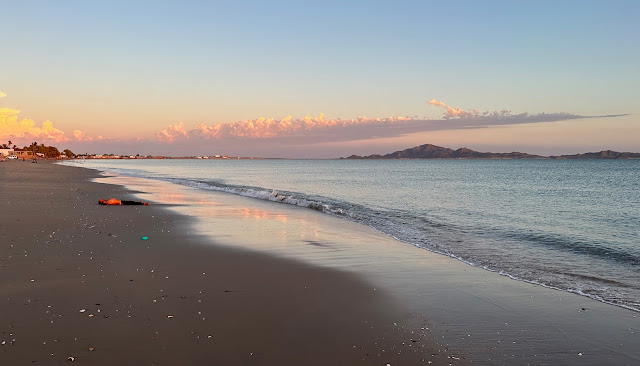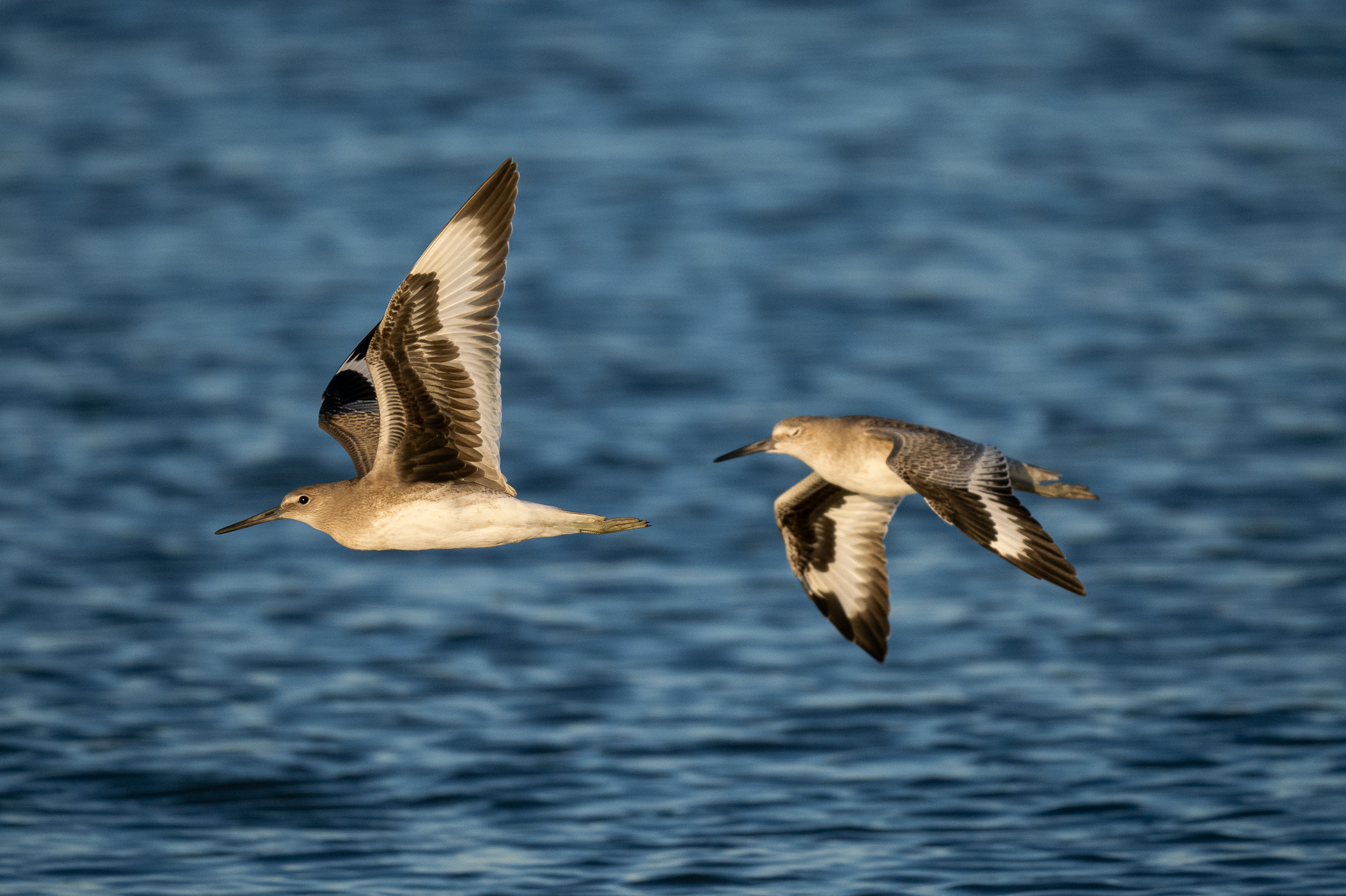The objective of my trip to Arizona was ostensibly the birding festival happening in Tucson. However, I have to admit that there were ulterior motives: namely, a road trip from Tucson down into northwestern Mexico that I had planned with some birding friends for the week following the festival. I had done something like this with Josh and Holly on my last trip to Arizona in 2021 (during an ill-advised hiatus from blogging), and it was one of my favorite birding trips I'd done thus far: a mix of great company, delicious food, gorgeous scenery, and of course lots of very nice birds. It was also my first time properly birding in the neotropics, despite living in South America for years back before I was a birder. It was a good enough time that I was itching for the chance to do it again.
The trip this time followed almost exactly the same itinerary I had done the previous time, with the ultimate destination being the town of Álamos in the far southeast of the state of Sonora. That meant that it was almost tailor-made to get me the fewest possible lifers of any trip I could take in the Neotropics, but mostly I was happy for the chance to look for some of the targets I had missed the previous time. Also, and maybe more importantly, it was a chance to do a fun birding road trip with good friends, after doing far too much solo birding travel this year.
Joining me this time were Mollee and Cedar, friends from the Birding Co-op. It was Mollee's first time birding in Mexico and Cedar's first time in northern Mexico so theoretically I was the most experienced with birds in the area. In practice, however, I've done 95% of my birding since my last visit in Southeast Asia, and I was utterly unfamiliar with anything New World-ish- particularly the annoying New World birds like Myiarchus flycatchers. Thankfully Mollee and Cedar were much more experienced, and nice enough to put up with my constant flagrant mis-IDs in the field- indeed, I couldn't have asked for better birding trip buddies.
Josh was nice enough to drive us from Tucson down to the town of Nogales on the Mexican border the morning of August 14, and we made it across with a minimum of fanfare. In fact, we never even had to show our passports to the Mexican border guard, nor at any subsequent point of the trip before we crossed back into the US; according to the Mexican government, we might as well have never been to the country. It certainly made things easier for us, although it was a stark contrast to the hell that immigrants and refugees face on a daily basis trying to get into the US- a humanitarian catastrophe and national embarrassment that only seems to be getting worse.
On the Mexican side of Nogales, we picked up our rental car and started the long drive south. Our destination for the first day was the town of Bahía de Kino, on the coast of the Gulf of California about 5 hours south of the border. The drive south was relatively painless, on well-maintained tollways through the Sonoran Desert. The terrain went from hilly desert scrub interspersed with wooded waterways near the border to a proper flat desert full of saguaro cactuses and dry arroyos. The latter part was inexplicably interspersed with almond and pistachio plantations, which seems to me like a wildly inefficient use of water in a desert environment. Then again agriculture in the US is wildly inefficient in general so maybe they were just learning from their northern neighbor.
 |
| The route down to Bahía de Kino |
I had reserved the cheapest AirBnb I could find in the area, and it proved to be an excellent choice- a lovely little bungalow located right on the beach, with a big kitchen and surprisingly effective air conditioning. It was late afternoon by the time we arrived, and of course the first thing we did after setting down our bags was to walk along the beach and look for birds.
 |
| The beach in Bahía de Kino |
The birds, as it turned out, were astonishingly plentiful: Western Gulls, Yellow-footed Gulls, and Heerman's Gulls flying back and forth over the beach and harassing Elegant Terns and Royal Terns, while higher overhead were thousands upon thousands of Magnificent Frigatebirds, wheeling overhead and congregating in enormous numbers over the craggy volcanic island just offshore. Out to see were dozens of Brown Pelicans, and distantly we saw flocks of White Ibises and even a few Blue-footed Boobies. The most surprising bird was a Black-vented Shearwater, a lifer for me, hanging out just offshore. I suspect it wasn't doing too well, as they're supposed to be flying around far out to see, but it was well enough at least to take off and fly short distances whenever people got too close to it.
 |
| Black-vented Shearwater |
 |
I believe this to be an immature Yellow-footed Gull, but farbeit from me to pretend I know how to ID immature Larus
|
 |
| Magnificent Frigatebird |
 |
| Brown Pelican, this one of the endangered californicus subspecies |
 |
| Thousands of frigatebirds wheeling around the offshore island |
 |
| White Ibis |
 |
| Atmospheric Royal Tern |
We decided to walk southwards along the beach to an area with slightly fewer people. That mostly worked, as there were indeed fewer people, although one of them was an old guy walking around with a beer who talked to me for about 20 minutes about how many alien sightings there were in the area. There weren't too many birds on the beach, but there was a group of Willets that posted in gorgeous sunset light, allowing me to get by far my best-ever pictures of this species. A Heerman's Gull flew by harassing a Royal Tern for its catch, and as we walked back we saw a single Snowy Plover following around the Willets. Lesser Nighthawks flew by as the sun set, and we had dinner at an excellent seafood restaurant next to the beach, including easily the best margarita I've ever had- Mexico!
 |
| Western Willet, because surely they will eventually be split... |
 |
| Immature Heermann's Gull |
 |
| Heermann's Gull being a jerk to a Royal Tern |
 |
| Snowy Plover |
 |
| Lesser Nighthawk |
 |
| Sunset in Bahía de Kino |
 |
| A truly excellent margarita |
 |
| Dinner selfie |
We were up bright and early the next morning, in time to see a beautiful desert sunrise. Our destination that morning was the estuary south of Bahía de Kino where I had birded my previous visit with Josh and Holly. We started at a little spit looking out into the bay, and had great looks at dozens of terns and gulls flying past- Least Terns, Elegant Terns, Royal Terns, Yellow-footed Gulls, Western Gulls, Laughing Gulls, and Heermann's Gulls. A few Black Skimmers darted past to round out the tern count, and we had a number of close flybys from Brown Pelicans, Willets, and dozens of Double-crested Cormorants. Onshore was a big flock of House Finches and Bronzed Cowbirds, a beautiful Hooded Oriole, and one of my favorite birds of the day, a trio of Gambel's Quails that walked past us on the beach!
 |
| Least Tern |
 |
| Yellow-footed Gull, a nice-looking gull restricted to the Gulf of California |
 |
| Elegant Tern |
 |
| Royal Tern |
 |
| Laughing Gull |
 |
| Brown Pelican |
 |
| Willets |
 |
| Double-crested Cormorant |
 |
| Gambel's Quail |
 |
| Hooded Oriole |
 |
| Sunrise over the estuary |
There was a nice wide mudflat on the other side of the sand spit, which was full of waterbirds. None of us had been smart enough to bring a scope and it was just about the worst possible light, with the sun directly behind most of the birds, but we were still able to accumulate a decent list- Long-billed Curlews, Marbled Godwits, Snowy Plovers, Grey Plovers, American Oystercatchers, Whimbrels, and Western Sandpipers to name a few shorebirds. There were several Yellow-crowned Night Herons around, including an adorably awkward immature bird, and some Reddish Egrets and Tricolored Herons as well- certainly two of the best-looking herons out there.
 |
| Adult Yellow-crowned Night Heron |
 |
| Baby Yellow-crowned Night Herons are ridiculously awkward and adorable |
 |
| Reddish Egret |
 |
| Zebra-tailed Lizard |
We drove slowly out of the estero as the sun got higher and the weather got hotter, stopping for birds along the way. There was a big group of Snowy Egrets, Reddish Egrets, Tricolored Herons, and White Ibises feeding in a small puddle, and in a little area of scrub we found some Large-billed Savanna Sparrows and many Verdins. Further on we stopped for few Gila Woodpeckers foraging close to the road and a little group of Wilson's Plovers, a nice addition to our shorebird list. Another surprise addition to our list was a male Lark Bunting that flew by- my first time seeing a male, and a new Mexico bird for all of us.
 |
| White Ibis |
 |
| Tricolored Heron |
 |
| "Large-billed" Savanna Sparrow- that bill do indeed be large |
 |
| Verdin- a weird penduline tit that somehow ended up in North America |
 |
| Gila Woodpecker |
 |
| Wilson's Plover |
 |
| Sonoran Spiny-tailed Iguana |
 |
| Large Mexican Fiddler Crab |
We finished birding late in the morning, then headed back to our AirBnb for quick showers and to check out. The rest of the day was a long drive southeastwards to the town of Álamos, but that will be the next blog post.



































































































Comments
Post a Comment